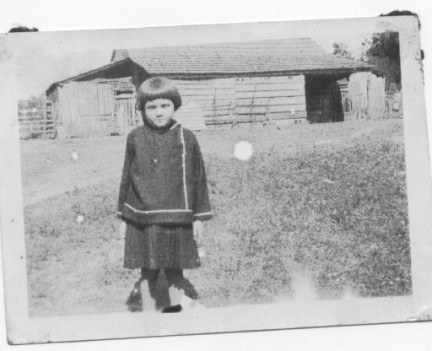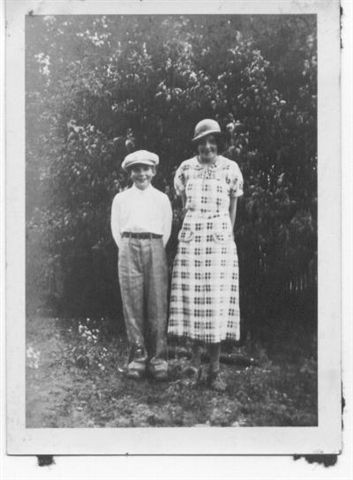|
Quannie's Story |
|
"Stories of gentle people" is some of the information
shown on Josephine’s Journal cards recently printed for me by the
Overton County News. The lady whose story I share with this
entry definitely fits in the category of gentle people. I would also
describe her as being someone with a lot of grit, determination, and
spunk, someone who made every effort to overcome difficulties she faced in
life beginning when she was only 8 years old. Born on November 21, 1921, this tiny baby girl was given the name Quannie Elizabeth, by Dr. L.F. Zachary of Livingston, who delivered her to parents Jasper Worley and wife Louella (Deck) Worley. Dr. Zachary had a daughter with the first name Quannie, and it was his suggestion that the Worleys’ baby daughter share his daughter’s name. The second name, Elizabeth, was Quannie’s grandmother Worley’s first name. Quannie was the fifth of six children whose names were Adolph, Gladys, Arthur D., Mabel, and Ward. Quannie was raised in a log house that stood not too far from the home she still lives in today. The log house belonged to her grandfather, Philander Deck, and it was in this same home that he lived with his mother during the civil war. When Philander Deck was only 10 years old, his father was away fighting in the civil war. |
|
This photograph was taken of Quannie when was around 6 years old. Her Grandfather Deck's barn is in the background.
|
|
She attended school at
Lone Maple the first through the eighth grades. One of the teachers she
had at Lone Maple was Troy Crabtree. In September of 1929, the year
Quannie was only 8 years old, she became very ill, the first symptom of
which was a very high fever. Severe pain all over her body and a drawing
of her right side soon followed. At first it was thought she might have
something called infantile paralysis. But that wasn’t it. She was
suffering from something much worse which turned out to be polio. The
same doctor who helped to bring her into the world was the person who
diagnosed the disease. Then, the only treatment recommended for polio
was something called "The Sister Kenny treatment" which consisted of hot
packs placed on the afflicted limbs. This meant that night and day, a
fire was kept burning in the wood stove of the Worley home for the
heating of pans of hot water. Towels placed in the hot water were wrung
out and then wrapped around Quannie’s right arm and leg. Her mother and
father, along with her sister, Mabel, all took turns making sure the
treatment was repeated around the clock for at least three weeks. Her
family was told that more than likely Quannie would never regain the use
of her right side, and in turn that would mean she would never be able
to walk again. But Quannie was determined that she would indeed walk
again, and that she would also regain the use of her right hand and arm.
And even though the phrase "physical therapy" hadn’t even been thought
of then, it was being given to Quannie by her family members on a daily
basis, and as a result, she did just exactly what she was determined to
do. In spite of having a limp, she learned to walk again, and she
regained the use of her right hand and arm. During the time the
paralysis was the worst, Quannie picked up her right hand with her left
hand, placed a fork or spoon in that right hand and fed herself.
Gradually, she was able to get the use of her right hand back, and
believes it was because she made herself use the right hand by helping
it along with the left hand. Quannie also remembers how people were
afraid to come to their home during the time she was so sick fearing
that polio might be contagious. And even though she missed almost a year
of school because of her illness, she doesn’t remember any of her
classmates treating her unkindly or making fun of her due to the fact
she became crippled from the disease. She remembers being able to
function fairly well when she was able to return to school, and that she
was able to catch up with her classmates regarding her school work.
Quannie became a young wife at the age of seventeen when she married Thurman Reagan. Most people knew him as Pete. Two years after their marriage, Thurman and Quannie had a son they named Lynn. Being of victim of polio didn’t deprive Quannie of reaching goals she set for herself. She very much wanted to prove to herself that she could do anything anyone else could do. One of the goals she had was to learn to drive. Her husband agreed to teach her, and after she learned, she even persuaded Thurman to sell a cow so she could use the money toward a down payment on a brand new 1965 bright orange VW. He later told her many times what a mistake he thought it was for him to have ever sold that cow! Another goal Quannie wanted so very much to accomplish during her adult life was to get her high school diploma, and when a course was offered at the Independence Elementary School at night, she enrolled. Charles Davis was the instructor. She told me it wasn’t easy, especially the algebra part which she very much disliked, but she completed the course, and went on the take her final test at Tennessee Tech and passed. Getting that GED was a dream come true. Quannie was 49 years old at the time. During the time their son, Lynn, was growing up, Quannie was a stay at home wife and mother. After Lynn graduated from high school, Quannie began working outside the home by staying with elderly people who needed a care giver. Then in 1965, she got a job at the hospital in Livingston as a bakery cook. For a while, she served as the food supervisor in the hospital kitchen, but then later returned to her old job as bakery cook. She held this job for 15 years and then retired. After her retirement, she was offered a job as care giver for Mrs. Eliza Windle, or Granny as she was affectionately known as. She and her husband, Thurman, left their home and moved in with Mrs. Windle so they might provide round the clock care for Granny. Shortly after their move into the Windle home, Thurman was diagnosed with cancer and lived only three weeks after learning he had the disease. After a short period away from the Windle residence following Thurman’s death, Quannie returned and remained Mrs. Windle’s companion and care giver for the next 14 years. During the early years of staying with Granny Windle, Quannie became acquainted with Columbus Garrett, and on June 11, 1983, she and Columbus were married in an outdoor ceremony in the front yard of the Windle home. Close family members and friends were in attendance at their wedding. The front porch and yard were decorated for the special occasion by Columbus’ son, Rick, and his wife Linda. Quannie’s brother, Ward, gave her away, and walked her down a red carpet that had been placed on the front porch steps of the home. Brother Edens performed the ceremony, and many of those attending the ceremony remarked to Quannie that the wedding couldn’t have been any nicer. Quannie and Columbus continued to live in the Windle home, and together, they cared for Granny until her death in 1992. There were times during the last years of Granny’s life Quannie thought she would have give up the job as Granny’s care giver, but just couldn’t bring herself to do so, even though the physical demands were taking its toll on her. She worried that Granny might think she was being abandoned if she were to leave because of her own health problems, so her love and devotion to Granny kept her on until Granny passed away. Had it not been for the help of Columbus, Quannie doubts that she would have been able to remain there. Today, Quannie and Columbus live a quiet life in their home near Taylors Crossroads. Columbus still makes a garden and shares vegetables with nearby neighbors. Although having polio was something Quannie had as a child, the long range effects of the disease are still something she has to deal with on a daily basis. In spite of the pain she has each day, she has a very positive outlook, and always looks forwards to visits and calls from neighbors and friends. She spends a lot of time reading and stays posted on current events by way of newspapers and television. She is 83 years old and Columbus is 79. Quannie’s extended family consists of two granddaughters, three great-grandchildren, two great-great grandchildren; four step-children; 7 step grandchildren; and 2 step great-grandchildren. Her son, Lynn, and granddaughter, Sheila, live nearby and regularly check on Quannie and Columbus, and help out by running errands for them when needed. I asked her about her unusual first name, and other than the doctor’s daughter she was named for, she didn’t know of another person who had that name. She laughed and said there was one consolation in having that name, her mail never got mixed up with anyone else. I think everyone who knows Quannie thinks of her as a gentle, sweet lady who inspires us to make the best of any situation we are faced with and to never give up on our goals and dreams. In spite of a doctor’s prediction many long years ago that Quannie would never being able to walk again, the spunk and grit she’s made of brought her through. Had she not had those characteristics, we can only wonder how this chapter of my journal would have been written.
|
|
Quannie Worley Reagan Garrett, around 14 years old, and her younger brother, Ward Worley, who was 12, are all dressed up to have their picture taken. Quannie bought the hat she's wearing at Coleman's Store in Taylor's Crossroads.
|

